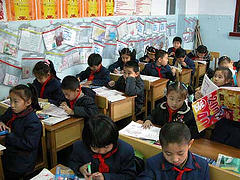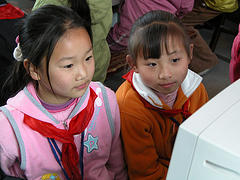Education system

Image Source: Flickr
The education system in China is divided into pre-school education, primary education, and regular secondary education. Pre-school, also known as kindergarten, can last up to three years. Children can enter pre-school at age three and usually enter elementary school around age six. There are two semesters per academic year.
Secondary education is optional, and options for a person are determined by an exam taken in lower middle school. Typically, a student starts secondary school at age 12. Secondary school lasts for six years. The World Bank says that as of 2007, 95% of Chinese students went to a secondary school. There are two basic routes: academic-based education and vocational education. Vocational schools can last two to four years, and are meant to train medium-skilled people to be skilled workers, farmers, managers or technical.
Higher education ranges from two to four years. In 2008, there were about 25 million university students in China. That number is 5 times greater than in 1998. Higher education public schools in China are difficult to get into, with students required to take an entrance exam known as the gaokao, and only the best students get into the public schools. However, private higher education institutions have been appearing in China. The tuition for these schools is higher than public schools, but for those with lower test scores, it is often their only choice. Additionally, China has allowed some foreign institutions to open in their country.
Schools' Access to ICTs: Stage 3
According to the CNNIC, 16.5% of students used online education at the end of 2008. Most middle and primary school students used the Internet for instant messaging, blog, network music and video. Basically, students are using the Internet for socialization and entertainment.
According to the China Internet Network Information Center, as of 2010, 30.7% of students have access to the Internet. However, within those numbers there is a divide. According the China Daily newspaper, only 12% of Internet users come from rural areas, where access is limited mostly to Internet Cafes where children are technically banned by law. Some computer labs are appearing in China to provide access for rural students, but access is typically slow and shared among many computers. Access is far more likely at home or at Internet cafes. The college level is the most likely place where students will find the Internet in heavy use, according to the CNNIC.
Because of the low prevalence of Internet access at the primary and middle school levels, China is at a Stage 3 for Schools' access to ICTs.
Enhancing Education with ICTs: Stage 3

Image Source: Flickr
According to Global Post, while there is now more than one computer per household in Shanghai, formal technology training in Chinese primary and middle school classrooms is lacking. Students may use computers, but it is largely through their own devices. They may use instant messaging and e-mail for personal use, but are unlikely to type up a paper.
For example, a teacher may assign students to give a presentation, and the students will use PowerPoint to put together their presentation. Students at this level may not even have time to play around on computers, assuming that they are available at all. Many parents require children at this level to study because they want their child to raise their test scores in anticipation of the secondary school entrance exams.
Because students often do not use computers in a classroom setting, China is at a Stage 3 for enhancing education with ICTs. This will become a Stage 4 over time as more tech-savvy people replace older teachers so that technology is integrated into the classroom, and older non-technical teachers are replaced.
Developing the ICT workforce: Stage 3-4
At the university level, students are able to find a wide variety of technical schools and programs at universities to grow their experience in information communications and computer science.
However, the Chinese education system is very rigid, according to the Economist. Students trained in China have solid grasp of theory, but employers are finding them unable to solve real-life problems, such as developing software. Employers are finding this problem often, even though the students are being trained at some of China's best universities.
There are few links between the education system and business in China, which may complicate matters. Many companies are sending qualified Chinese students to school for extensive training in countries such as Japan. One company, GrapeCity, routinely sends students to Japan for additional training—at a cost of $60,000 per student. Even then, GrapeCity found only 10-20% of the students were then performing at levels expected of the company.
China is between Stage 3 and Stage 4 for developing the ICT workforce. The educational system lacks the critical link between business and university that prevents the many trained workers from being used to their full potential. Also, while training on subjects is certainly available in the country, often employers must look outside the country for appropriate training.